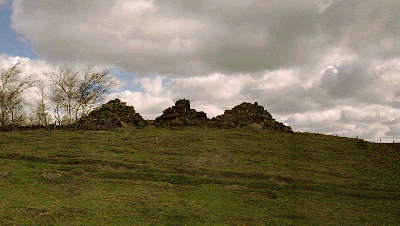
Three small cairns stand on the southern end of Gardom's edge, conical stoneheaps that have been added to by climbers and walkers for years. Established at some point in the last two centuries, these cairns have come to be known as the "Three Men of Gardom's".Some say they were built as memorials to three shepherds who died in the snow; others that it was three drunken priests who perished after losing their way. The 'Three Men' were raised on older foundations. Beneath them lies a much larger and older barrow, a low, circular mound composed of rounded gritstone boulders partially obscured by turf. The location and form of the mound is typical of many Late Neolithic/Early Bronze Age barrows in the Peak District.

Why did Later Neolithic or Early Bronze Age people choose to build a large barrow in this place? Immediate answers are hard to come by as the site has yet to see any systematic excavation. However, the long history of research on barrows and cairns in the region does provide a few clues. Over 500 barrows have been identified across the Peak District, the majority established during the Late Neolithic and Early Bronze Age (2500-1500BC). All are circular mounds of earth and/or stone, often associated with features such as kerbs, cists and rock cut graves.Many of these sites were excavated with varying degrees of accuracy during the mid-19th century, most notably by antiquarians such as Thomas Bateman and Samuel Carrington. Since that time, more detailed recording has added much to the general picture established by them.
Current evidence suggests that barrows were raised over the remains of the dead; inhumations and cremations have been found in many examples. However, histories vary from one site and area to another and we should allow that these places may have held a varied significance for people at the time. Sometimes begun as open areas for the exposure of bodies and for other forms of observance, many barrows were built and elaborated over protracted periods of time - certainly years and perhaps even generations. It is also clear that some barrows remained important for 'secondary' burials long after the mound was first constructed. Unfortunately, our evidence for the treatment accorded to the dead is geographically biased. Human bone survives reasonably well in the alkaline soils of the Limestone Plateau, but has little chance in the more acid soils on the Gritstone. The visibility of the dead on the grits depends largely upon whether or not remains were cremated prior to burial, as this increases the chances of survival.
How were the dead regarded? From the first antiquarians onwards, it has been a commonplace to assume that these mounds were raised over the remains of people who had held a certain status in life. Early accounts often talked of 'Chieftan's graves', emphasising cases where bodies had been found in association with what were regarded as 'rich' grave goods; daggers, axes, pots and other bodily adornments.Such arguments miss much of the variety in the evidence. Many burials are lacking in material associations, and it is likely that other themes may have been equally (if not more) important to people at the time. Questions of identity, authority and renown would certainly have been crucial. But for many communities, what was also important was the continuity of life from one generation to the next and the sense of tenure that they had with specific parts of the landscape.
The close relationship of barrows to field systems throughout the Eastern Moors suggests a tradition of burial that held a local significance for specific groups of kin. Some may have been founded close to land that was used seasonally or on a more periodic basis, but many were constructed so that they overlooked particular cairnfields.We should not assume that all were built for the same reason, but it does seem that many served as important points of reference for particular family lines. They were places at which the dead could be remembered and honoured, where the bones or ashes of later generations could be laid to rest alongside older burials. They were also places where the living could renew their links with the past and seek the help of their ancestors. Seen as people moved with stock, or vantages from which people could gaze out across lower ground, many barrows were probably visited for the performance of periodic rites that stressed the genealogical connections between people, land and the past.

Cremation Pit
Burial in barrows was just one way in which the dead could be honoured. Ashes and bone may have been scattered in ways that leave no archaeological signature, and this is one reason why it is impossible to make reliable estimates of prehistoric population levels from human remains. Cremated bone has also been found in some of the agricultural cairnfields of the Eastern Moors. Caught up in the fabric of smaller mounds related to the clearing of ground, the dead were a physical presence amongst crops and pasture, reminders of the legacy that the living had inherited from earlier generations.Cremations were also placed in urns in open cemeteries. Examples of this practice have been identified on the south-western edge of Stanton Moor and on Eaglestone Flat above Baslow, which can be seen from Gardom's Edge. Often lacking any physical markers on the surface, these cemeteries may have been relatively common, other examples lying undiscovered beneath the surface of the moors.